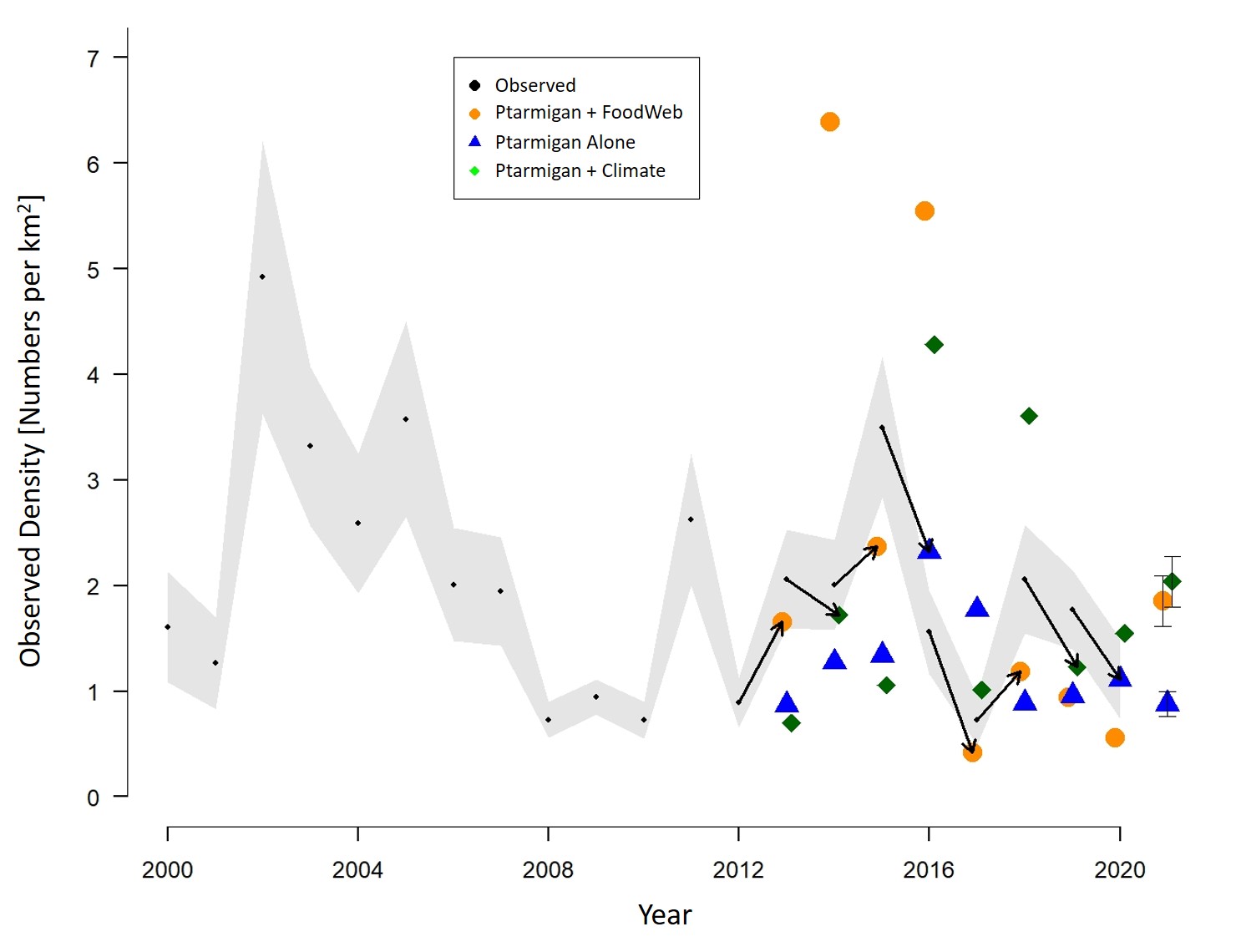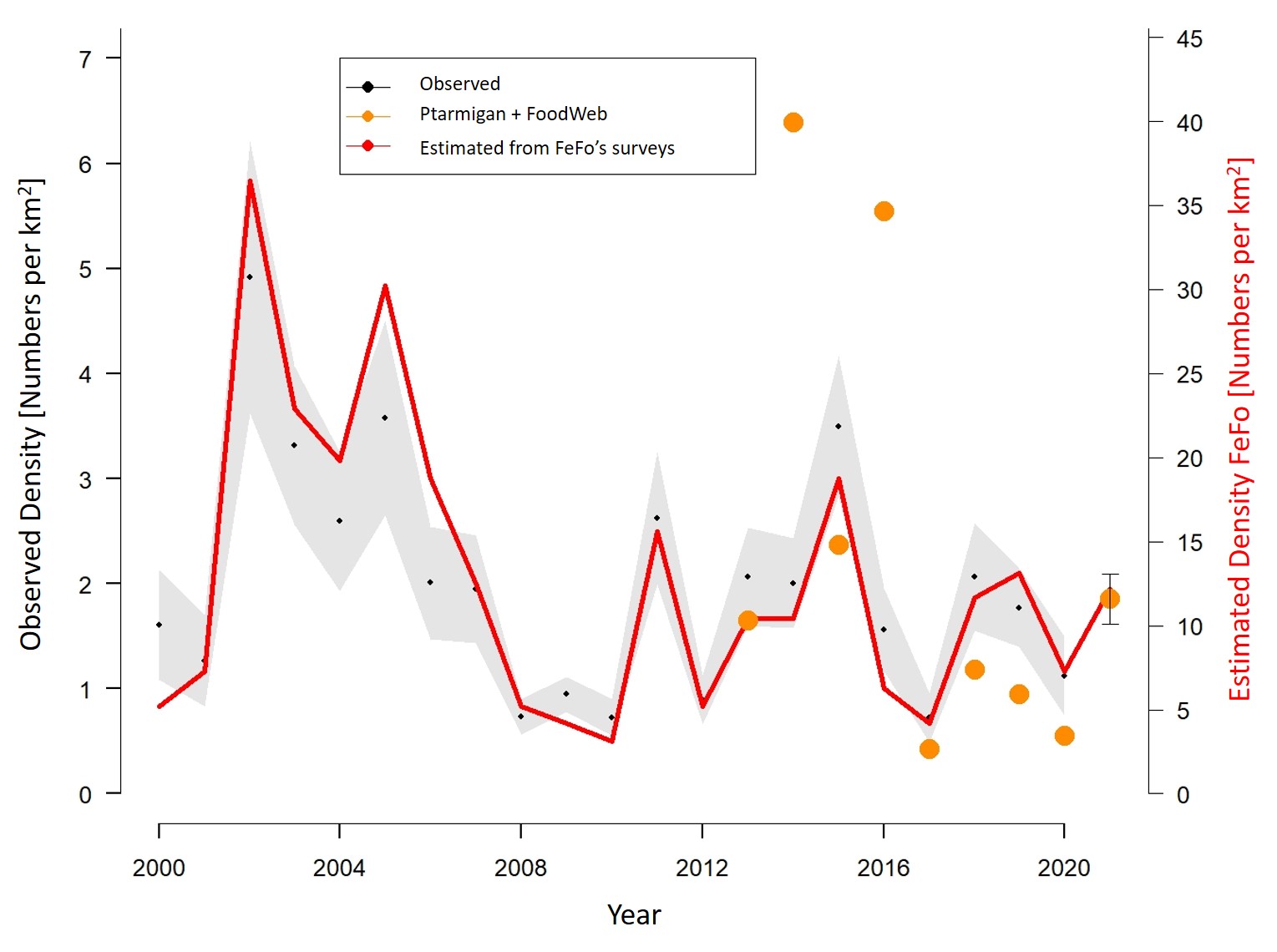COAT has modeled the population fluctuations of willow ptarmigan in Finnmark and looked at what influences changes in the population. The modeling is the result of a collaboration between COAT, the research project SUSTAIN and several stakeholders, including the landowner Finnmarkseiendommen (FeFo). The stakeholders wanted the models to be used to predict the ptarmigan populations one and a half months before the annual line-transect surveys, in order to be able to plan the year's hunting, quotas and management in advance. COAT has therefore, for the first time, made model-based predictions before this year's ptarmigan surveys. The results of FeFo's assessments are now also available and these largely correspond to the predictions that were made.
Figure 1. Food web model that shows different drivers and their contribution to the population development of the willow ptarmigan populations in Finnmark. In the red boxes, positive numbers indicate effects that have a positive effect on the density of the ptarmigan and negative numbers show effects that have a negative effect. The size of the numbers indicates the strength of the effect. Note that the effect of moth outbreaks through vegetation changes is in reality a negative effect.
COAT-models for willow ptarmigan
Our statistical models, which are now based on more than 20 years of data, show that the most important drivers of ptarmigan density in the autumn (see model in Figure 1.) are precipitation during the hatching period, start of the winter the autumn before (mismatch in plumage change), the small rodent dynamics, the carcass availability in late winter for the ptarmigan's predators and the extensive moth outbreaks that have taken place in Finnmark. To a lesser extent, the ptarmigan population is affected by the temperature around hatching and hunting the year before.
The statistical models used to predict the density of willow ptarmigan in the autumn in Finnmark are based on large-scale population data on willow ptarmigan from FeFo and Hønsefuglportalen and food web data from COAT over the last 21 years in Finnmark.
This year’s model-based predictions
This year's predictions (Figure 2.) show that we expected a slight increase in ptarmigan density this year, especially the two models that have important climate and food web drivers. This was because it was a relatively normal start to the winter last autumn in addition to a fairly hot and dry period in June / July, when the chicks were newly hatched. In addition, a couple of years with low small rodent densities, as well as relatively few carcasses of reindeer this winter, has likely resulted in fewer predators in the system. A caveat one should take is that the sum of all these positive effects in the last year probably does not work purely additive to each other, and that the increase compared to the years before in Finnmark as a whole seems to be somewhat less than what has been predicted.

Figure 2. COAT's predictions of this year's observed ptarmigan densities (numbers seen / km2) one and a half months before the line-transect surveys were made. This year's predictions are given with confidence intervals that indicate the uncertainty surrounding the estimate. The colored symbols show the predictions from three alternative statistical models that vary in assumed influencing factors and complexity - of which the food web model (orange dots) is the most complicated (see Figure 1). The observed ptarmigan densities up to the year 2020 are shown as small black dots in a curve where the gray field denote the margin of uncertainty. The arrows point to the model with predictions that is closest to the observed values ??for each year's prediction.
Figure 2 shows that the model that best predicts the counts one and a half months before they were made, as well as the accuracy of the predictions, varies from year to year. This is because the different drivers affect the dynamics of the ptarmigan to varying degrees from year to year. Nevertheless, it is still interesting to see that the models have become increasingly better at predicting next autumn's ptarmigan density. This is because the models are updated annually with new information and more data, which means that the models are based on driver data that increasingly represents natural dynamics and thus the connection between density and the various drivers. In addition, it can be seen that the food web model in particular, is increasingly appearing as the best model for predicting ptarmigan density in the autumn. This demonstrates that an ecosystem-based approach to ptarmigan management gives the best results in the long run.
This year's model predictions vs. the survey result
FeFo recently published the results from this year's suveys in Finnmark from Hønsefuglportalen (figure 3). It is gratifying to see that our predictions overall correspond well with the result of the surveys in the sense that the change from year to year is similar both for those predicted from the model and the observed / estimated densities based on the line-transect surveys - especially over the last 5 years.

Figure 3. The figure show the estimated density of the willow ptarmigan population in Finnmark in the period 2000 - 2021 (red line, data from FeFo) compared with the predictions from COAT's food web model in the last 9 years (orange dots). Note that our model predicts the average observed number of ptarmigan per km2, while the assessment result (red line) is given as the estimated number of ptarmigan per km2 from a model that corrects for detectability (i.e. a distance model). More detailed data on the estimated production and density of willow ptarmigan in different parts of Finnmark can be found on FeFo's website.
The value of making predictions
The prediction of an increase in willow ptarmigan populations in Finnmark for 2021 was received as good news for small game hunters and for the landowner FeFo. The head of the department in FeFo, Einar J. Asbjørnsen stated in a news letter on FeFo's website the following: «We are very pleased with the collaboration with UiT in this research project. The knowledge that emerges from this is useful to us as a landowner, and means that we can to a greater extent than before be able to plan and carry out a balanced and sustainable small game hunt on the Finnmark estate».
FeFo further states that such "early assessments" have often been vague and characterized by more or less qualified views in the past, while with these models they have now been provided with a tool that allows them to make well-qualified assessments on a more professional basis than before about the prospects for this year's hunt, before the assessments have been completed. This is clearly stated in another comment from the head of the department in FeFo, Einar J. Asbjørnsen: “The SUSTAIN project has been useful for us as a landowner. We will take the results from the modeling with us in assessments of, among other things, how many hunting licenses to allow for sale in the individual hunting grounds. For the years to come, we have an expectation that the models will come with increasingly precise forecasts, as the time series becomes longer. Nevertheless, it is important to remember that these are models, and that the assessments carried out by local volunteers these days will still be the most important basis when final regulations for small game hunting are decided”.
Assessments of willow ptarmigan production
FeFo also estimates the number of chicks per female ptarmigan. These show that willow ptarmigan has had a relatively low chick production this year (see FeFo's website). COAT makes similar assessments for both willow and rock ptarmigan in a large area in the western part of the Varanger Peninsula in eastern Finnmark. FeFo does not monitor the latter species - which is a valued small game in Finnmark. From COAT's assessments (figure 4), we see that the production for rock ptarmigan is on average somewhat lower than for willow ptarmigan, but with a more marked increase during the last year than what we see for willow ptarmigan in this region.

Figure 4. Estimation of chick production (Chicks per female) for both willow and rock ptarmigan in one area west on the Varanger Peninsula (Bergebydalen and surroundings). The figure shows an increase in the production of rock ptarmigan, while no change for willow ptarmigan, compared with last year.
Other prediction models in COAT
COAT is working on developing similar prediction models for a number of other populations, both in Finnmark and on Svalbard. A model for Svalbard ptarmigan has already been developed (Understanding and predicting how climate change impacts Svalbard ptarmigan population dynamics). Work is now also ongoing on similar models for domestic reindeer, moths and small rodents. In addition to providing management-relevant information to various stakeholders and end-users, such prediction modeling provides a very honest test of how well we understand the dynamics of ecosystems and how climate change affects this dynamic.